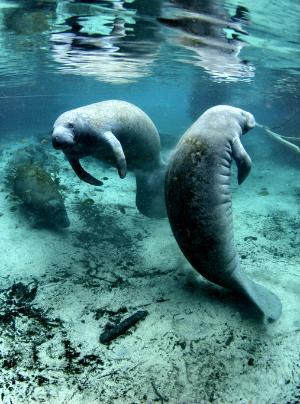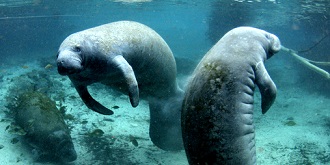Threatened and Endangered Freshwater Species in Florida

Manatees at Crystal River, FL / Photo Credit: David Hinkel USFWS
Florida is home to a number of species, including freshwater plants and animals, whose numbers are in decline. A species is “listed” by the U.S. Fish and Wildlife Service (FWS) when it is determined to be endangered or threatened because of the following factors:
- present or threatened destruction, modification, or curtailment of the species’ habitat or range
- overutilization for commercial, recreational, scientific, or educational purposes
- disease or predation
- inadequacy of existing regulatory mechanisms
- other natural or manmade factors affecting the species’ survival.
Before a plant or animal can receive protection under the Endangered Species Act, it must be added to the Federal lists of threatened and endangered wildlife and plants. These lists contain the names of all species of mammals, birds, reptiles, amphibians, fishes, insects, plants, and other creatures determined to be in the greatest need of protection.
The lists categorize plants and animals according to their degree of peril:
- Endangered: A species in danger of extinction throughout all or a significant portion of its range.
- Threatened: A species likely to become endangered in the foreseeable future throughout all or a significant portion of its range.
- Candidates: Species for which the FWS has enough information to warrant proposing them for listing, but is precluded from doing so by higher listing priorities. The EPA works with stakeholders to carry out conservation actions for these species to prevent further decline and to possibly eliminate the need for listing.
- Species of Special Concern: A state government list denoting a species or population that warrants special protection, recognition, or consideration because it has an inherent significant vulnerability to habitat modification, environmental alteration, human disturbance, or substantial human exploitation which, in the foreseeable future, may result in its becoming threatened or endangered.
Species may also be listed by a state regulatory agency such as the Florida Fish and Wildlife Conservation Commission (FWC). The FWC has constitutional authority to “exercise the regulatory and executive powers of the state with respect to wild animal life and freshwater aquatic life, and shall also exercise regulatory and executive powers of the state with respect to marine life….”
View the FWC's list of Florida's Endangered and Threatened Species.
Rules and regulations are developed and enforced to limit human activities likely to further jeopardize vulnerable species. For complete information about rules and regulations to protect listed species in the U.S., visit the U.S. Department of Interior, Fish and Wildlife Service (FWS) website.


